Thanjavur, or Tanjore as it is sometimes stylishly referred to, is a historically significant place in Tamil Nadu. Even among other places of storied interest in the region, it occupies an important place in the culture, history and geography of the Tamil country. The city of Thanjavur, and its surrounding area, nestled in the lush, fertile Kaveri delta has been the seat of empires, center of religious movements and has nurtured and developed major schools of art, architecture, painting, music and dance.
My personal connection to Thanjavur, for most of my life, rested on the fact that I lived there between the ages of 6 and 10, and many of my earliest memories are connected to that city. Later, as I describe in my Origin Story, I also learnt that it is the land of my ancestors, who lived in the village named Nadukkaveri, which is about 30 kms from Thanjavur.
On a recent visit, I found that while there have been some changes that appear to acknowledge that it is now the 21st century, Thanjavur is still very much the small, semi-rural town that I remember. Of course, the ravages of the pandemic stalled the flow of tourists, but the town is now starting again to bustle and hum with activity.
There is much to savor in terms of sights. The magnificent Brihadeeswara temple, built in the 10th century by the great King Raja Raja Chola is still the colossus that dominates the skyline. This is, of course, world famous, so I will not attempt to describe its appearance, or its history – a picture should suffice, instead of a thousand words.
The Chola empire that Raja Raja Chola and his successors expanded across the seas to Sri Lanka and all the way to parts of what are now Malaysia and Indonesia, eventually declined. Other rulers gained ascendancy there – first the Pandyas, then the forces of the Delhi Sultanate and then the Vijayanagara empire.
In the 17th century, it became the capital of the so-called Southern Maratha kingdom – beginning with the rule of King Ekoji Bhosale (also known as Venkoji), who was the younger half-brother of the more famous Chhatrapati Shivaji (you can read an unusual story about him here). Although there were attempts by Shivaji to incorporate this Southern kingdom into his empire, the younger brother preferred to be independent – after a brief period when Shivaji’s forces defeated him in battle and forced him to accept the elder Bhosale’s suzerainty, the kingdom reverted to independence after the Chhatrapati’s death.
Sadly, the legacy of the Maratha kings of Thanjavur is not well preserved. The longest serving king, Raja Serfoji II was a great patron of the arts, and acquired a large collection of books, manuscripts and paintings, which are preserved in the Saraswati Mahal Library pictured below. However, the adjoining palace and other structures have decayed and deteriorated and there isn’t much of the grandeur of the Maratha kings that is left to be seen.
There is much more history to be discovered even in random nooks of the town. Drawn by childhood memories of the Sivagangai Poonga (Sivaganga Gardens), where I remembered colorful figures of animals among slides and swings where I played, I walked there to find it in a sad state of decay. However, I discovered a heritage building there, carefully preserved by the Archeological Survey of India, that very few people seemed to know about – a church built in 1779, by a Danish missionary, identified only by the single name Schwartz, in the plaque at the entrance.
Obviously, none of the sights above have anything to do with a statue whose words need to be read, so we can finally come to the subject of this essay. This is a statue of much more recent vintage, and is one which I remember seeing and hearing about on the day it was installed, and it must have caused quite a stir, to so firmly imprint itself in the memory of a 2nd grader. In fact, almost anyone who has lived in Thanjavur in the past 50 years will know this landmark. Why do I remember it so well, after all these years? The answer to that question, is the point of this essay. This statue is most famous for its headline – the first set of words inscribed on the base of the statue, and it is unlikely that anybody gets beyond that one line. Now, when I visited Thanjavur, I resolved to go beyond the headline, and read ALL the words on that statue.
It is situated in a prominent location in Thanjavur, next to the main bus stand. Unveiled on September 17, 1969, the subject of the statue was himself present at its inauguration, which was unusual. The stir created by the unveiling of the statue, and indeed, its continued notoriety over the past 50 years – almost anyone who has visited or lived in Thanjavur during this period knows the first line of the inscription on it – is entirely due to that very first line. So this essay is an attempt to go beyond just that headline, the first line, and an examination of the whole message on that statue. Was this just an attempt at provocation and designed only to enrage and poke fun at his political opponents? Or was there an entire political and social philosophy that was captured by ALL the words on that statue?
Let us start with the first set of inscriptions at the front –
With breathtaking simplicity, the message gets straight to the point, and as I wrote above, it is the headline that grabs your attention, and doesn’t allow anybody to get beyond it – here’s a translation:
God does not exist
He who teaches about God is a fool
He who spreads the word of God is a crook
He who prays to God is a barbarian
Circle to the left of the statue, and on that base, are these words –
The man who does not know to think is a fool
The man who is afraid to think is a coward
The man who refuses to think is a bigot
Only the man who thinks is rational
Next, we circle to the right of the statue, and there, we find these words –
The “Soul”, “Heaven”, “Hell”, “Reincarnation”
These are ideas taught by dishonest persons
And he who believes in them is a fool
He who profits from these is the most dishonest one
Next, let us look at the words on one of the main panels of the statue –
Expanding on the concepts so explicitly laid out on the base –
God does not appear naturally to anybody
Grownups teach children the concept,
Showing them the idols and inducing these thoughts
In the future, all those who teach about God will disappear from the world
The subject of the statue then goes on to explain his mission in the next panel –
For about 50 years, I have been fighting for the rights
of those who are said to belong to the ‘lower castes’,
so-called, only based on the scriptures and religion.
My struggle has been to liberate these ‘lesser‘ people
from being exploited and ill-treated, and that is the sole purpose of my life
Now, it is time to look at one final panel on the statue. If you were wondering what this leader is recommending as the basis of that future society, where religion and God, and the societal structures created by them do not exist – that answer is here – the Golden Rule!
“Do unto others as you would have them do unto you – that is morality“
This, then is the statue that has stood for over 50 years in a prominent location in Thanjavur. It is still meticulously maintained, and the statue is frequently garlanded and decorated by adoring followers. Since 1969, this statue has boldly propagated the rationalist ideas of the subject of the statue, and it seems very likely that he wrote these words himself.
There can be no better example of the wonderful contrasts that you can see in India. Less than a kilometer from one of the grandest, oldest and holiest Shiva temples in South India, stands this monument to rationalism that articulates a clear vision for a different future – that the only path to a future casteless society is one where religion, and its core concepts, are completely uprooted and destroyed.
The statue is a life-size sculpture of E.V.Ramasami (1879-1973), the founder of the Dravida Kazhagam or DK, from which the DMK and AIADMK parties sprang, and that have dominated Tamil Nadu politics for the past 60 years. Referred to adoringly as ‘Thanthai Periyar’ (Thanthai = Father; Periyar = Respected one), he was a social activist who founded the ‘Suya mariyadai Iyakkam’ (Self-Respect Movement), whose main aim was to abolish the caste system, erase the traditional hierarchy of the ‘lower’ and ‘upper’ castes in Indian society and establish a society based on economic and social equality.
Here, then, is a full view of the statue


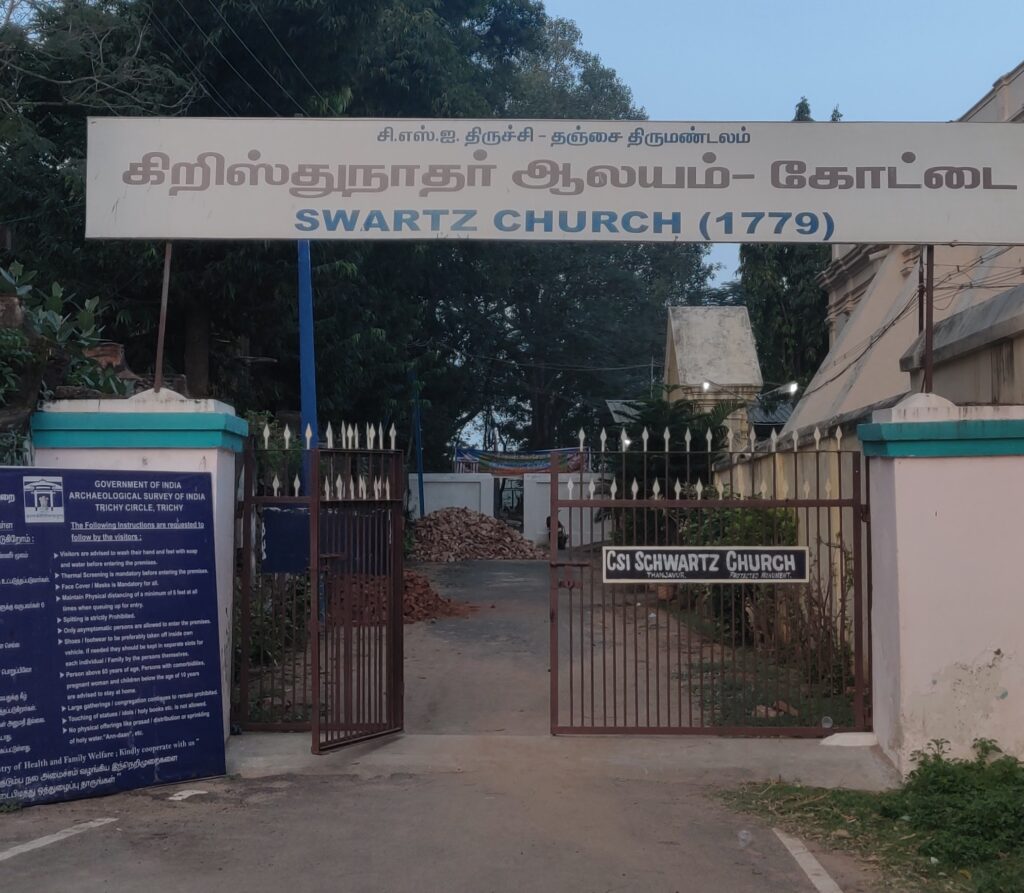
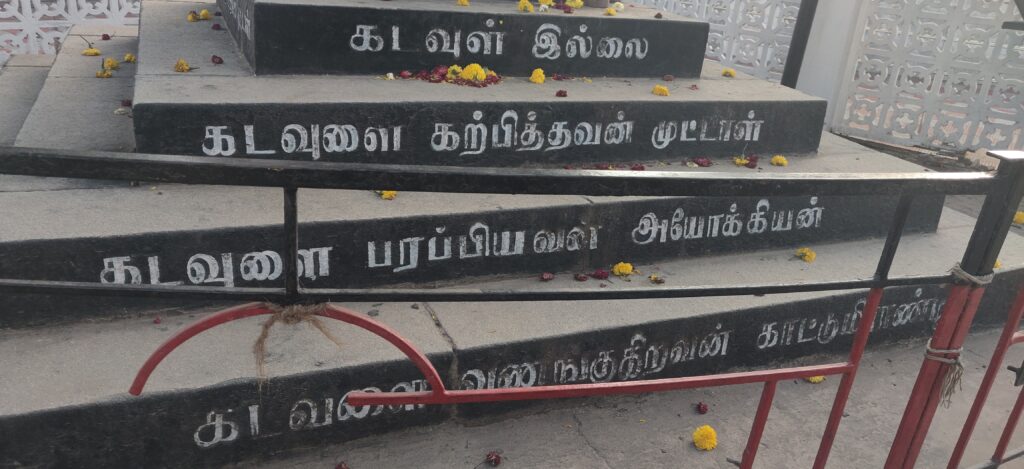


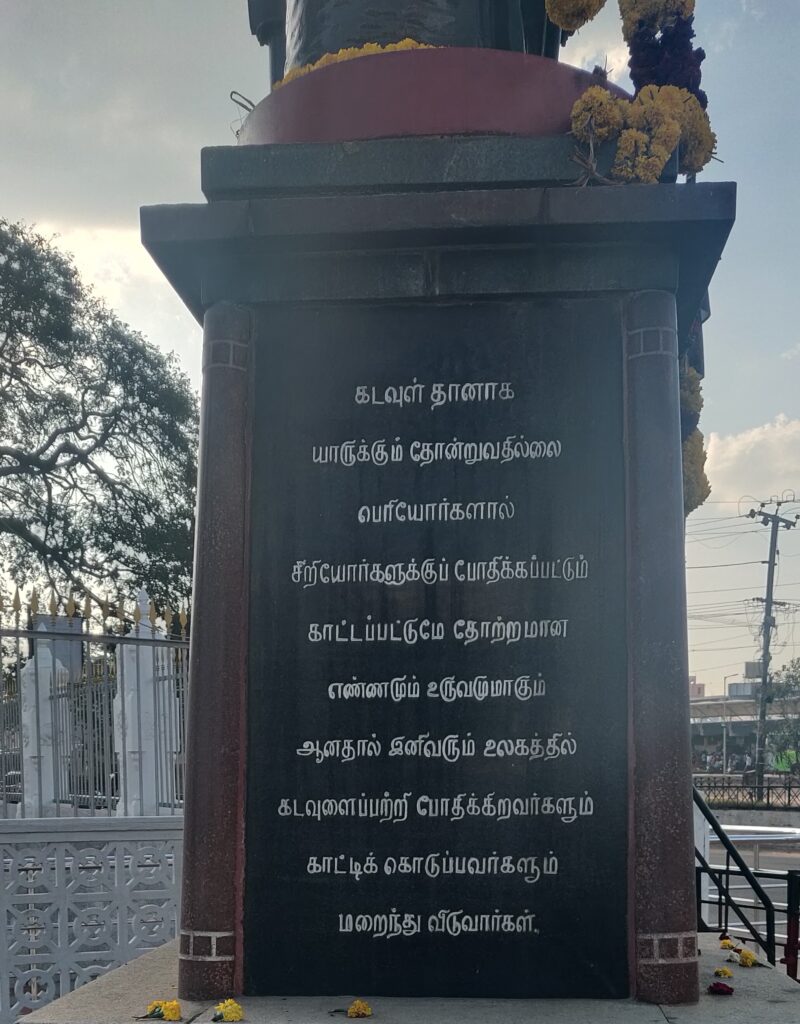
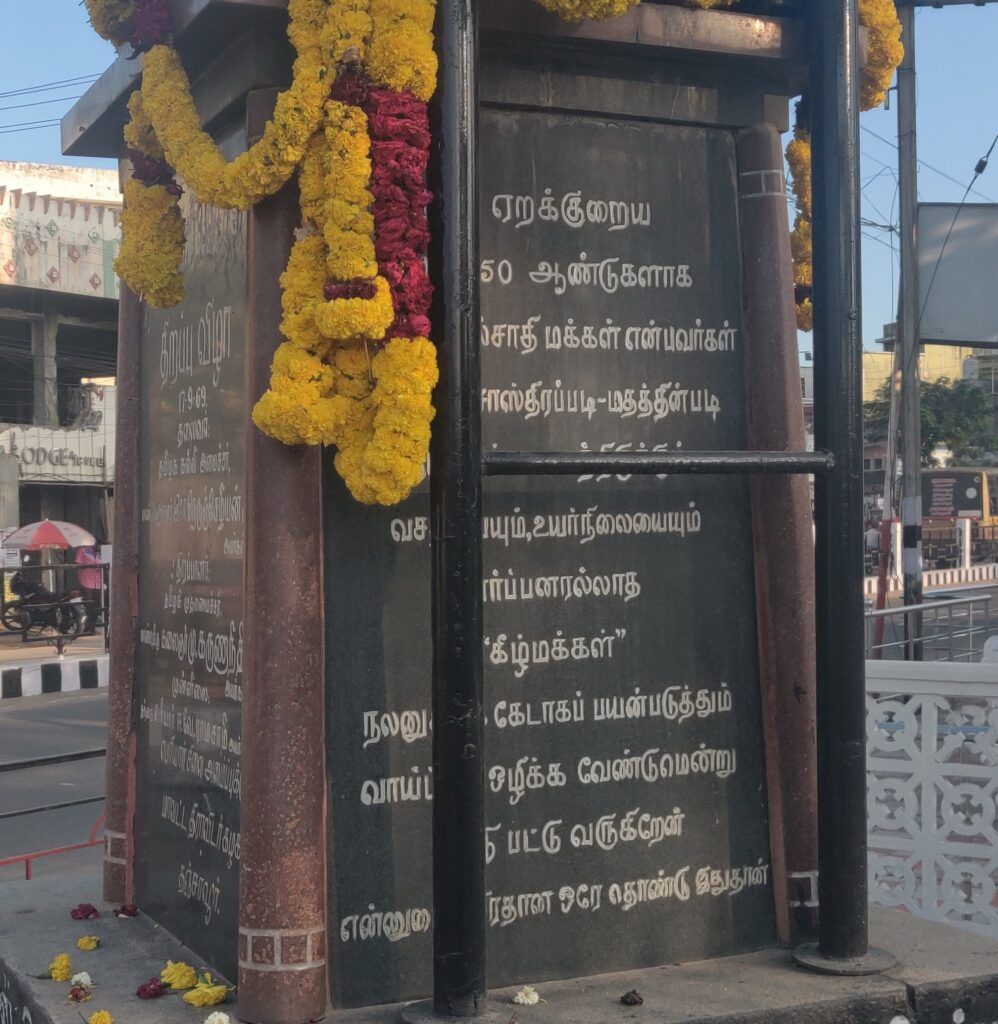
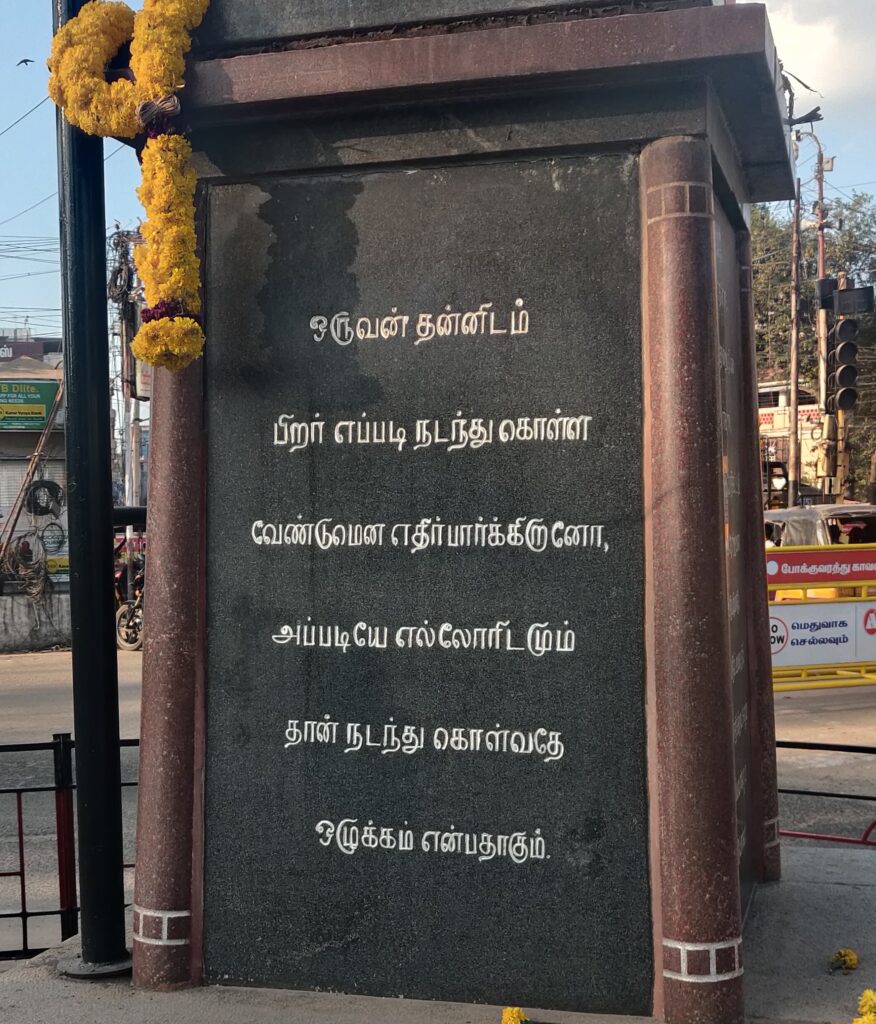
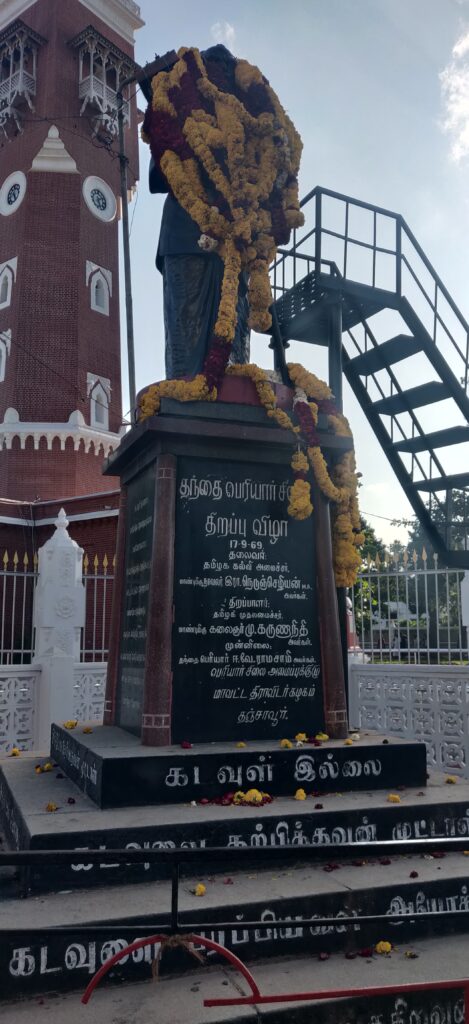
Dravidian movement in Tamilnadu (barring whatever shortcomings it had and subsequent versions adopted by the political parties) has left an indelible mark in transforming the lives of majority of the so-called oppressed classes. It is a fact none can deny.
Thanks. I only know periyar as person of political importance. My Tambram friend hates him. My Tamil wife (non Brahmin) is neutral, leaving me none wiser. Knowing about him is on my To do list and this was a good Segway